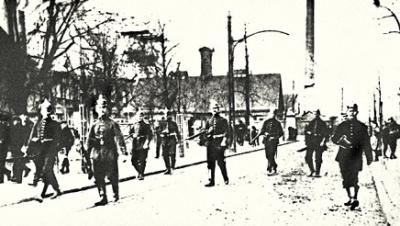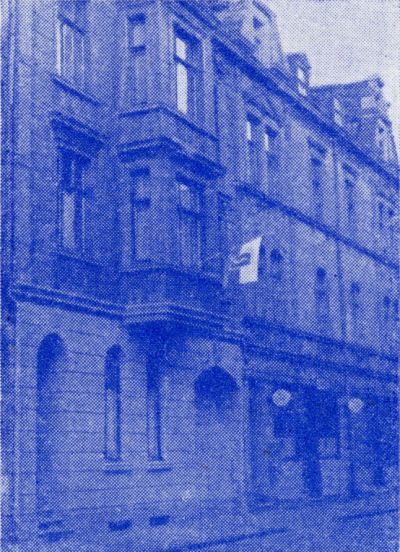The “Herne Polish Revolt” in 1899

The so-called “Herne Polish Revolt”, also known as the “Herne Riots”, in the summer of 1899 was a strike that got out of control and which mainly involved Polish miners - economic migrants from Prussia’s eastern provinces. The direct catalyst for the strike and the acts of violence that followed was the increase in contributions to the miners’ welfare fund, which were to be deducted directly from their wages. On Sunday, 25 June 1899, the board of the Social Democratic Mining and Steel Workers’ Association, prompted by the atmosphere that was brewing in Herne and elsewhere, organised a meeting and warned the workers against acting rashly. One Polish speaker, who could have had a calming effect on the workforce in Herne, did not get a chance to speak because the meeting was terminated. The next day, several hundred miners and steelworkers went on strike and a dark and violent atmosphere developed because the strike action was not channelled properly. The strike, which started at the “Shamrock” and “Friedrich der Große” mines and in which even the miners’ wives took part, spread to six mines in Herne and involved between 1,800 and 2,500 strikers. On 27 June, during skirmishes between the strikers and the police force, two miners were shot and killed and 14 more were injured – these events have been imprinted on the collective memory of Herne locals as the “Slaughter in Bahnhofstraße”.
A state of siege was declared in Herne and the surrounding area and the authorities called in the military, which then marched into Herne with two infantry battalions and a cavalry squadron to support the police in suppressing the strike. On 29 June, which was Peter and Paul Day, the priest of the Herne congregations attempted to influence the strikers from the pulpit and move them towards restraint and abeyance, and the editorial team at the influential Polish Catholic newspaper “Wiarus Polski” published an appeal to the Polish workforce and distributed posters calling for them to keep calm and not let themselves be stirred up. The Alte Verband and the Trade Association of Christian Workers reacted in a similar way and asked their members to stay away from the strike and attempted to calm down the young and foreign-speaking workers who were on strike. The only organs to be calling for strike and revolution, presumably on the instruction of the Polish Socialist Party (PPS) in Berlin, were the Association of Polish Workers in Herne, “Przedświt” (Sunrise), an offshoot of the Polish Socialist Party (Polska Partia Socjalistyczna, PPS). At least it is documented that calls to strike were made in the spirit of socialism; however, it is not completely certain who made these calls for which, ultimately, members of the PPS offshoot in Herne were persecuted by the police and punished by the courts in the aftermath of the strike.
As a result of the strike, which continued until the beginning of July 1899, at least six striking miners were killed and several hundred people were injured, some of them severely. More than 500 miners were dismissed from the mines when the strike ended. Of the 192 strikers who were disciplined by the authorities, 157 were Polish workers and five were Masurians, most of them under 25 years old. On top of this, there were more than a dozen arrests which resulted in court proceedings. Some of those arrested were sentenced to several months’ imprisonment for reasons including acts of violence, threats and attempts to agitate those willing to work to join the strike. Some of those receiving long prison sentences, for example, are documented as being members of the association “Przedświt”, which was not even a year old and which the authorities and the press accused of being “inflammatory agitators” responsible for the outbreak of the strike and for keeping it going for several days. The association, which only had 20 members, was dissolved as a result.
However, the causes of the strike that got out of hand were much more complex than simply blaming the increase in member contributions to the miners’ welfare fund and the rabble-rousing activity of a Socialist group that really had hardly any influence on the Ruhr Poles. The strike also cast a new light on the working and living conditions of the Polish migrants, whose numbers had drastically increased since the end of the 1880s, and highlighted the fact that they were lacking trade union representation. With the exception of some of the Polish-speaking economic migrants from Upper Silesia, who were experienced or trained miners when they arrived in the industrial region of Rhenish-Westphalia, the migrants from the eastern provinces of Prussia, most of whom were young, were right at the bottom of the workers’ hierarchy. The lack of language skills and the mental barriers made relations with the German-speaking workers much more difficult and they did not share the same interests. The existing trade unions, like the Alte Verband and the Trade Association of Christian Workers, neglected the Polish migrants. During the strike, the Trade Association published a call to its members stating that the Polish workers could hardly be classed as real miners. The existing trade unions did not provide clarification to the Polish workforce of the changes that had been made in terms of the wage contributions, nor did they stand up for the Prussian Poles when the so-called language paragraph came into force in Dortmund’s upper mining authority area in 1899. This paragraph dictated that, in future, the safety provisions in the plants and mines would only be posted in German – instead of safety, however, this meant new dangers for the majority of workers who were not proficient in German. In addition, the so-called “Prison Law” was being debated in the Reichstag at this time, the intention of which was to restrict the right to assemble and strike, which generally drove the workforce in the Prussian state to the barricades.
The events of 1899, and central amongst them the “Herne Polish Revolt”, triggered discussions within the Polish workforce and the circle of Polish intellectuals around “Wiarus Polski”. They debated the extent to which the Polish workers on the Rhine and on the Ruhr were represented at all by the existing trade unions and whether it was necessary for them to create their own trade union representation. Jan Brejski, politician and publisher of “Wiarus Polski”, was instrumental in pushing this idea through and turning it into reality by creating the Polish Professional Association (Zjednoczenie Zawodowe Polskie, ZZP) in 1902. Within just ten years, ZZP grew to become the third biggest trade union confederation in the whole of Germany. In 1912, the Bergarbeiterzentrale, which was headquartered in Bochum, had 30,000 of the country’s 70,000 members.
David Skrabania, November 2018
Literature:
Tenfelde, Klaus: Die „Krawalle von Herne“ im Jahre 1899 (Internationale wissenschaftliche Korrespondenz zur Geschichte der deutschen Arbeiterbewegung, 15. Jg. 1979, Heft 1), p. 71–104.
https://wiki.hv-her-wan.de/index.php?title=Herner_Aufstand_1899 [accessed on 28/10/2018].


